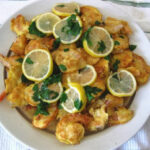Rosengarten Classic. Originally Published: The Wine Enthusiast, August 2008.
Just a friendly reminder: OUT OF THE POOL, EVERYONE…IT IS HIGH PLUOT SEASON!!!
Now, if you’re reading this in California, it probably comes as no news to you…because your markets and farmers’ stands are overflowing with scrumptious pluots (pronounced PLU-otts) just now. But if you’re reading this elsewhere in the U.S., chances are you’re saying…plu-WHAT?
Yes, if you’re non-left-coast….you need to get up to speed on one of the most seductive fruits ever developed. Since I got the religion, I actually wait all year long for pluot season…with no less passion than I reserve for strawberries in June, corn in July, tomatoes in September, and Nantucket scallops in winter.
The pluot, quite simply, is a cross of the plum and the apricot: about 75% of the former and 25% of the latter. Fear not: there is no evil breeding going on here, no Manichean attempt to wreak havoc on the natural order, no genetic manipulation. The pluot belongs to a group known as interspecific fruits: natural crosses between different but related types of fruits, achieved in the orchard, not in the laboratory.
The work that yielded the pluot was done in California by Floyd Zaiger in the 1980s; by the early 1990s, orchards throughout California’s Central Valley—particularly in the San Joaquin Valley—had begun producing pluots, and sending them to market. Pluots could actually grow in almost all of the 50 states, but California remains, by a huge margin, the leading pluot producer. Given the late date of pluot’s birth, and the Cali-centric-ness of it all, there’s no need to feel embarrassed by being behind the pluot curve—but now that you’ve read about it, you’d be mad not to get on the bandwagon!
Why is this thing so good? The answer has nothing to do with apricots, and everything to do with plums. Apricots have less acid than plums—so the pluot blend has lower acid than plums, emphasizing the new fruit’s incredible sweetness. The apricot is lusher in texture than the plum, richer in mouthfeel—and that’s exactly what you get in the pluot as well. And, because the apricot has a gentler, less bitter skin—the pluot is also much more come-hither.
In short, the pluot tastes like some kind of phenomenal super-plum—the best of which are, without question, better than the best plums I’ve ever tasted. They’re bigger, heavier, more velvety, more of a presence; imagine the difference between a spatlese and a beerenauslese, and you’ve got it. And don’t try to find the flavor of apricot in a pluot; you must simply appreciate the subtle things that the apricot has devoted in service of the plum.
There are almost two-dozen varieties of pluots that have been developed; less than half of that amount is in regular commercial production. The varieties can be surprisingly different from each other. Last week, I was privileged to receive five different pluots, each one peak-season, from a fabulous Fresno-based company called Bouquet of Fruits. The company began with the Paul family growing fruit over a hundred years ago, has morphed and modernized in many ways, and is currently a leader in the effort to develop ever-better fruits…many of which come from Kingsburg Orchards in Fresno County, under the supervision of breeder extraordinaire Mike Jackson.
Here’s what I tasted, in ascending order of delirium:
Mango Tango Pluot. Yellow skin with red speckles. Yellow fruit inside. Nice poppy bite, but slightly dry in spots. Medium sweet, good acid, mild plum taste.
Midnight Jewel Pluot. Purple skin with gold speckles. Reddish flesh near the skin, white-ish inside. Low-key plum flavor, but incredibly juicy, with zingy tartness matching the sugar.
Sugar Beaut Pluot. Light purple skin, with a grey-green veining. Ruby-grapefruit flesh. Incredibly sweet, almost jammy, with kind of a gooey-creamy chew.
Raspberry Jewel Pluot. Dark-plum-purple exterior. Wine-like ruby-red flesh inside. Drippingly juicy—and the drips are full-bore dark red! Meaty, tender and delightful, with an excellent plum flavor bordering on a red-wine flavor.
Flavor King Pluot. If you can arrange to taste one pluot only…this is the one, my friends. I have confirmed this in the past by tasting the fruits of other orchards. The Flavor King Pluot is insane. Dark red skin, slightly flecked with gold. Watermelon-colored flesh, but yellow at the core. So sweet you begin to wonder how a fruit can get this sweet—but, due to lively acid, not cloying. A plum flavor so deep, so intense, it seems like an artificial flavor, a candied plum, a parody of plum—but it is real, jackson. Superb creamy-juicy texture, with droplets of joy dribbling all over your shirt.
To arrange purchase and delivery, log on to: www.bouquetoffruits.com
Photos: Jeremy Brooks/Flickr Creative Commons & Baldor Foods








